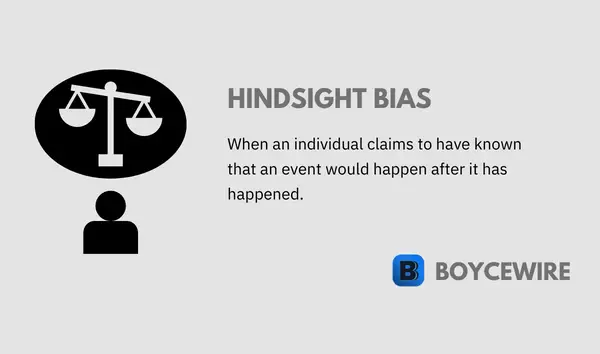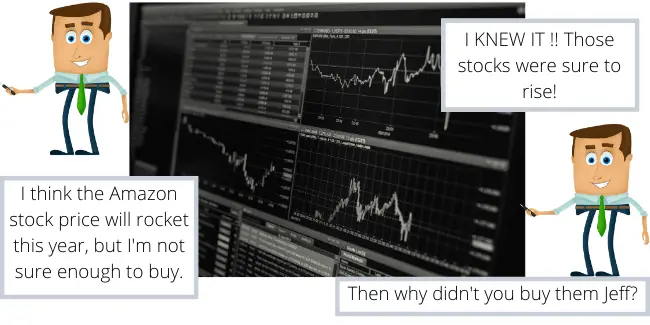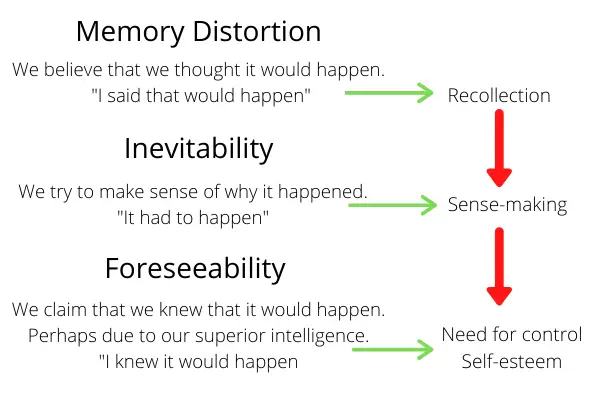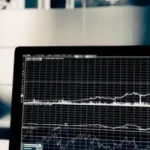Hindsight Bias: Definition & Examples

What is Hindsight Bias
Hindsight bias is where an individual claims to have been able to predict an event after it has happened. For example, they will state, ‘I knew that would happen’. However, their belief of that outcome was significantly lower before the event. It is only after the event occurred that they believe their initial feelings were stronger than they were.
For example, a stockbroker may be uncertain about a stock and decides not to buy it. However, two months later, its value increases by 50 percent and they claim ‘they knew it would rise’. Yet the feeling they had at the time was not strong enough for them to take the risk and invest.
Key Points
- Hindsight bias is where the individual perceives the likelihood of an outcome to be significantly higher once it has happened.
- People will believe that they thought the outcome was ‘certain’, even though they may not have been sure before.
- With hindsight, it seems like we knew the outcome before it took place and therefore believe that was our original thought.
If we take another example – Mr. and Mrs. Ryan are at the dog racing after a meal at a local Italian. They decide to watch the 7 pm race. Mrs. Ryan likes the look of ‘Luna Runner’, but she is not convinced that she will win. She thinks the odds are 50/50 at the time.

After much toing and froing, Mrs. Ryan decides not to place the bet as she is unsure. Later on, they both watch the race and Luna Runner wins. ‘I knew she would win’, Mrs. Ryan states. In her mind, she thought Luna Runner was a sure winner. However, she is recalling her thoughts after the race and thereby inflating her originally predicted odds. So rather than thinking Luna Runner was a 50/50 bet, she recalls that she thought it was close to 100 percent.
To conclude, hindsight bias occurs when individuals believe that they correctly predicted the event before it occured, even though they were not certain.
Hindsight Bias Examples

1. Hindsight Bias in the Court Room
In court, the defendant is prone to become the victim of hindsight bias. For example, there may have been a homicide case where the defendant shot the victim. However, the defendant claims that they did not know the gun was loaded and thought it had the safety on.
Although the defendant is still liable for negligence when in possession of a firearm, there may be a question of intent. At the time, it may have been perfectly reasonable for the defendant to make such claims.
Yet these thoughts were proven wrong after the event, which can, in turn, lead the jury to hindsight bias. They know the gun was loaded and had the safety off, but they weren’t there before the incident. So, their only perspective is that after the event, which leads to an inflated likelihood that the defendant actually knew.
2. Stock-market
Let’s take another example of hindsight bias. For example, John thinks Company X is a good buy at $1 a stock. The company sells consumer goods and the economy seems to be doing well – suggesting it might be a good buy. However, John isn’t too sure and is unwilling to invest money into the company.
The year later, the stock increases to $2 a stock. John then claims he knew they would go up. Yet he didn’t buy them because he wasn’t sure.
In hindsight, John believes that he thought the likelihood of Company X gaining value was higher than in reality.

3. COVID-19
During the Coronavirus outbreak of 2020, many journalists believed that China was employing unnecessary draconian measures when the outbreak started. Human rights abuses were claimed with the country putting many regions in lockdown.
At the time, it was seen that it would never reach the rest of the world, with it being seen as just another localized disease. The likelihood was seen as very low, with many governments not even bothering to prepare for such an event.
However, once it spread throughout the rest of the world, journalists changed tune – claiming that we knew it was coming and did not prepare sufficiently.
4. CEOs
When an idea gets proposed, the CEO may say ‘let’s go for this’, but a competitor goes for an even better strategy. In turn, it costs the CEO’s company millions and is a complete failure.
After the event, the CEO announces ‘I never liked that idea in the first place’ and instead puts the blame on their subordinates. It is easier for them to put the blame on others when it goes wrong instead of taking responsibility and damaging their ego. Equally, it is easier to take the credit when things go right.
5. Fishing
A father and son go out fishing one day. The father says to his son that its about the experience and not catching the fish – already expressing his doubts about getting a catch. However, after spending a few hours at the lake, they catch one. ‘I knew we’d catch one’ the father exclaims – despite his initial reservations about their success. The hindsight bias therefore occurs as the father believed that he knew they would catch one after the fact, even though he wasn’t sure before.
Hindsight Bias and Overconfidence
Hindsight bias leads people to believe that they knew things all along. This makes us believe that we have a great perception of reality and our ability to predict the likelihood of events that we truly do.
Event after the event occurs and hindsight bias leads us to believe that we predicted the outcome, even though we may not have been sure prior to the event. Consequently, it can inflate our perception of ourselves, which can lead to dangerous decision making.
If we tell ourselves something enough times, we can start to believe it. That includes ‘being right’ all the time. It tends to re-enforce itself when people are in social groups as people aim to boost their egos and impress friends.
We can take a classical example of a group of friends trying to find their way around in a foreign country. ‘I know where I am going’, one exclaims. Even though they have never stepped foot in the country before, they somehow know. Highly unlikely, and shows how hindsight bias is a contributory factor in such overconfidence.
Levels of Hindsight Bias
The three levels of hindsight bias were originally proposed by Roese & Vohs (2012) in their paper that was published by the Association for Psychological Science. They proposed three levels which were:
- Memory Distortion (“I said it would happen”)
- Inevitability (“It had to happen”)
- Foreseeability (“I knew it would happen”)

Memory Distortion
In hindsight bias, memory distortion is the tendency to recall previous thoughts and believe that an event was predicted prior to it occurring. Hence, ‘I said it would happen’.
For instance, it may be believed that the likelihood of ‘Mr. Example’ becoming President is 30 percent. At the time, it may be said ‘I think he will become President, but I’m not sure’. However, once the event has occurred and Mr. Example becomes President, the recollection of the believed likelihood of that event is increased to almost certainty.
So when memories are recollected, they are almost seen as black and white and in certainty. In this way, it helps our brain process the world around us. By doing so, the event that occurred starts to make more sense.
Inevitability
Inevitability builds upon the previous level of memory distortion. Not only are previous beliefs exaggerated, but there is also a belief that ‘it had to happen’. This can be seen as the factors that contribute to the outcome happening. In other words, it was obvious Michael Jordan would score that hoop, he was the best in the world.
First of all, the individual believes they thought an event would occur (memory distortion), and then with hindsight, they are able to identify factors that meant it had to happen (inevitability). Studies have shown that when in high-controlled situations, people will tend to use inevitability as a coping mechanism (‘I never had a chance’).
For example, a 100m race may be run and the winner wins by 2 seconds. The others may think ‘I never had a chance’. Yet prior to the race, they thought the opposite. Only with hindsight do they believe that the opportunity to win was non-existent. In doing so, it helps make sense of the situation.
Foreseeability
The foreseeability level is largely subjective as it is based on an individual’s perceptions of their own ability (‘I knew that would happen’). The perception is that they knew the outcome before the event, but in reality, they were not as certain as they believed. This also builds upon the previous levels of memory distortion and inevitability.
Within foreseeability, people will believe that they knew because of their superior knowledge, expertise, or intelligence. For instance, a specific stock on the S&P 500 rockets by 10 percent in one day. ‘I knew that would happen’. As a result, the outcome seems like it was foreseeable. The individual had control and understood the situation and predicted the result. At least, that is what hindsight helps us believe.
Foreseeability is the next level up from the others as it is at this level by which people use hindsight to build self-esteem and feel in control. At memory distortion, the event was said to be known. Then at inevitability, people try to make sense of it all. After which, it moves on to self-esteem and alleviating feelings of a lack of control.
FAQs on Hindsight Bias
Hindsight bias is where an individual claims to have been able to predict an event after it has happened.
The problem with hindsight bias is that we tend to believe that we knew things all along. This bias tends to make us believe that we are right all the time, leading to an inflated sense of ego and poor decision making.
When an idea gets proposed, the CEO may say ‘let’s go for this’, but a competitor goes for an even better strategy. In turn, it costs the CEO’s company millions and is a complete failure.
After the event, the CEO announces ‘I never liked that idea in the first place’.
About Paul
Paul Boyce is an economics editor with over 10 years experience in the industry. Currently working as a consultant within the financial services sector, Paul is the CEO and chief editor of BoyceWire. He has written publications for FEE, the Mises Institute, and many others.

Further Reading
 Floating Exchange Rate: Definition, Pros, Cons & Example - A floating exchange rate is where the value of a nation's currency, when compared to another, is determined by supply…
Floating Exchange Rate: Definition, Pros, Cons & Example - A floating exchange rate is where the value of a nation's currency, when compared to another, is determined by supply…  Autarky Definition and Examples - Autarky is a self-sufficient economic state without international trade, but can limit growth due to higher costs, limited access to…
Autarky Definition and Examples - Autarky is a self-sufficient economic state without international trade, but can limit growth due to higher costs, limited access to…  Common Stock: Definition, Characteristics & Examples - A type of financial asset that represents ownership of the company.
Common Stock: Definition, Characteristics & Examples - A type of financial asset that represents ownership of the company. 